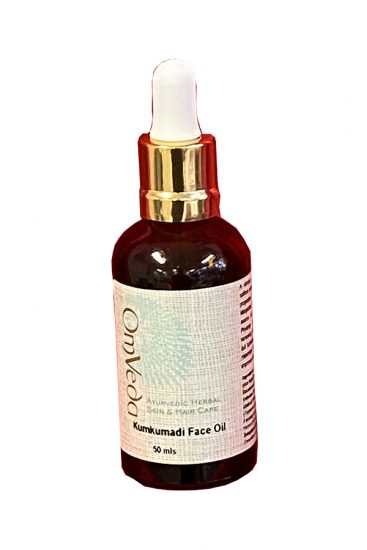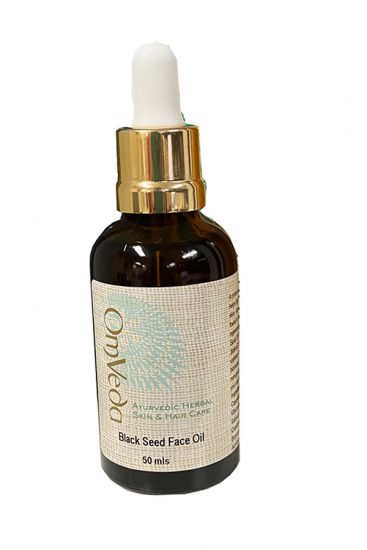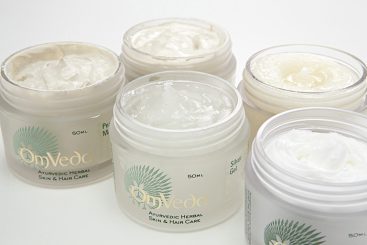Beauty Blog
RICE BRAN OIL, AN ANTI-AGEING INGREDIENT YOU’LL LOVE
You can find it in our Blackseed and Kumkumadhi Oils, and it’s powerful when it comes to keeping your skin looking dewy and youthful.
Rice Bran Oil (Oryza sativa) contains an abundance of benefits, so let’s get on with it and tell you more.
It’s a first-rate hydrator thanks to its Oleic and Linoleic Acids (fatty acids), which help skin retain high amounts of hydration. It’s also packed with Vitamins and firming Q10. Together, these components aid in reducing lines and wrinkles, boosting elasticity and evening out dark spots and dusky markings. Its Vitamin E content makes it a brilliant nourisher.
Rice Bran Oil is also a rich source of antioxidants such as Gamma Oryzanol, Ferulic Acid and Tocopherols. Antioxidants strengthen the skin’s defence and help guard against premature ageing.
Oryzanol (Gamma Oryzanol) is a potent anti-ageing complex with antioxidant and anti-inflammatory benefits. It kicks up micro-circulation, addresses pigmentation, deeply moisturises dry skin and balances natural oil production.
Ferulic Acid neutralises free radicals and guards against oxidative damage, which can cause wrinkles and lines. It also has anti-inflammatory, offers UV protection, reducing UV-induced damage and soothing benefits to address sensitivities.
Tocopherols are a Vitamin E complex including alpha, beta and gamma. Vitamin E can help protect skin cells from oxidative stress, UV radiation and other ageing concerns; in addition, Vitamin E nourishes and soothes.
Now we’re familiar with the benefits of Rice Bran Oil.
It’s time to go a step further and take your routine to a new level by incorporating our blockbuster and supercharged Blackseed and Kumkumadhi Oils. All the benefits of Rice Bran Oil PLUS a powerhouse mix of active and pure Ayurvedic herbs to make your complexion glowing and dewy in the short term. With continued use … healthy and happier skin. The bonus is they’re lightweight and absorb in a flash for a softer and velvety smooth skin.
Our restorative Black Seed Oil, a lighter textured oil, brings the skin back to life, and its texture makes it a perfect warmer-weather oil. While set in a base of Sesame Seed Oil, it’s boosted with Rice Bran Oil, which is overflowing with polysaccharides, proteins, antioxidants, minerals and other phytonutrients, 100% natural Black Seed Oil and Jirakadi, a combination of Black Sesame and two varieties of Cumin. It’s a potent formula and the latest in our facial oil lineup. Helping to build a healthier skin structure and integrity, it also targets ageing issues, blemishes, dark spots, redness, inflammation and scarring.
Evening out tone, refining texture, minimising under eye circles and calming, our Kumkumadi Oil is powered with 26 precious Ayurvedic herbs to keep skin supple and smooth while addressing lines. It includes mainstays of Saffron and Turmeric with Madder, beautifying Rose, anti-inflammatory Liquorice, Vetiver to hydrate and the essential oils of Bergamot and Lavender.
Yasmin suggests using just 2-3 drops, as a little goes a long way. You can also mix in a few drops with your day and night creams for an extra boost of hydration, or it can be used alone.
Either way, your skin will be supple, radiant, healthy and youthful. Isn’t it time to switch up your routine?
Find them at https://www.omveda.com.au/face-oils-serums/
HAIR OILING, A SIMPLE WEEKLY ROUTINE for healthy glossy hair
HAIR OILING, A SIMPLE WEEKLY ROUTINE for healthy glossy hair
Did you know that a healthy scalp equals healthy, glossy hair?
Hair Oiling is a long held Ayurvedic practice and a tradition in India where every woman’s hair is super lustrous and silken.
Now it’s big news and trending on social media. And there’s a reason, it works wonders, has unlimited benefits and is very relaxing.
While we all know beautiful hair is a status symbol, however keeping it that way with constant styling, chemical processes including colouring, curling and/or straightening can weaken the hair’s roots, cause dryness, dandruff and make the hair lifeless, dull and brittle. Outside elements, particularly UV rays is another culprit that damages the hair. So an oiling treatment is essential to scalp and hair health.
A weekly hair oiling is simple and takes just minutes. It’s not a matter of just soaking the scalp and hair in oil. The art of massage using the fingertips is just as important.
Massaging oil into the scalp helps boost circulation, which takes oxygen and nutrients to the hair follicles, it conditions the scalp, reduces dandruff and flakiness, strengthens hair roots, reduces hair fall, stimulates hair growth, guards against premature greying, eases frizz, replenishes dryness, reduces brittleness and split ends, increases hair lustre and manageability and leaves hair silken and soft.
It also helps relax the mind and relieve everyday stress.
Treat your scalp and hair before showering in the morning, at night or make it your Saturday routine using one of our herbal oils ~ Brahmi, Neelini or our all-rounder, Herbal Hair Oil.
Apply the Hair Oil and gently massage in, comb through to the ends of the hair before showering or taking a bath, leaving it in for 30 minutes.
You can also apply, massage in and leave on overnight. Be sure to cover your pillow with a hand towel. In the morning simply shampoo out as normal using a natural hair cleanser. Strands will be super soft, silky and shiny afterwards.
Team your hair oil routine with one of our shampoos ~ Amla, Green Apple or Henna.
Our Hair Oils:
Combines Brahmi, Gota Kola, Ashwaghanda and Valerian to reduce hair concerns associated with stress while promoting relaxation. A perfect night-time remedy for the hair and the mind.
A nourishing oil to help prevent hair loss and dandruff, boost strong growth and hair thickness. It is also beneficial in treating head lice, the formula blends Hibiscus and Aloe..
Fenugreek and Amla in a base of Sesame Oil boosts hair lustre and scalp health. Ideal for sun damaged, chemically treated, out of control and extremely dry hair.
NURTURING SENSITIVE COMPLEXIONS
Temperamental and touchy, often overheated, red, irritated, inflamed, uncomfortable and sometimes itchy. Sound familiar?
Sensitivity can be a short-term or ongoing issue.
Short-term, it can be triggered by a number of factors including harsh, aggressive or too active products, cleansers or serums for example, abrasive exfoliators, scrubbing too often or way too vigorously, products containing alcohol, such as toners, moisturisers loaded with fragrance, chemicals and synthetics and over-use of hot water.
You’ve lived with sensitive skin for as long as you can remember and tried everything to calm, soothe and heal it.
Enter Pure Silver …..
Silver was valued and used in ancient times as an anti-bacterial and anti-microbial agent, in the control of infections and wound healing and to strengthen the immune system. Throughout time Silver has effectively treated many skin problems, thanks also to its power plus anti-inflammatory and healing benefits. It has also been used in the medical world for wound management and dressings.
Silver in Ayurveda is recognised to have exceptional cooling qualities and restorative benefits that help pacify sensitive skin and reduce its symptoms.
It is a remarkable ingredient that subdues excess heat and minimises redness, rosacea and irritation. Soothing and reviving the overall appearance of sensitive skin, it also relieves the tight, uncomfortable feeling often associated with inflamed skin.
Silver also helps restore the natural pH of the skin which is very important as an upset or out of balance pH can lead to a weakening of the protective barrier. This can allow irritants to penetrate and compromise the skin’s overall function. The skin’s barrier, aka the acid mantle, is responsible for protecting it, by keeping in moisture and locking out pollution, toxins and bacteria.
We use pure and precious Silver Leaf and other selected soothing and healing Ayurvedic herbs in our Silver product range ~ Silver Toner, Silver Gel and Silver Day Cream. Together they work to nurture sensitive skin and leave it calm, supple and renewed.
Why is grated potatoe good for the skin
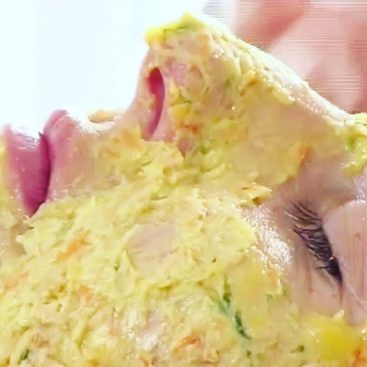
Added grated potato to your face mask? Is it a thing?
Yes, and the extra benefits for your skin will surprise you.
We know how yummy the humble potato is … in a bake, mashed, roasted or fried, however, did you know it makes a fabulous and pampering skin friend?
Potatoes contain nutrients like Vitamins C and B6, Potassium and Flavonoids that work together to help reduce wrinkles, redness, and irritation.
In addition, Potatoes contain Magnesium to help boost elasticity and moisture, Zinc to regenerate, antioxidants to help protect the skin against free radical damage and, azaelic acid (generally found in grains like wheat, barley and rye) to brighten the skin, fade hyperpigmentation and scarring, and also address other concerns such as acne and rosacea.
The anti-ageing properties present in Potatoes can also improve collagen content thereby improve the skin’s overall appearance. Natural moisturisers and rejuvenators, they also help boost skin health and keep it clear. They are also helpful in exfoliating the skin and their starch gives the skin a natural glow.
Potatoes are champions when it comes to the skin, and it’s easy to include them in your skincare routine.
For a fabulous mask that’s deeply nourishing and hydrating, add finely grated Potato to our Mango Butter Face Mask https://www.omveda.com.au/product/omveda-mango-body-butter-face-pack-50mls/together with finely grated cucumber and carrots – a healthy feast for your face. .
DRY HERBAL BODY BRUSHING – UDVARTA
Brushing the body beautiful
“In true Ayurvedic tradition, Udvartana is a body toning program using a combination of herbal powders and oil on the entire body. The unique ingredients used in the formulation help remove excess fat, fluid and fatigue and tone the skin by kick-starting circulation.” explains Yasmin.
Doing wonders for both body and skin, the Ayurvedic practice of dry body massage has been around for centuries. It’s beneficial for improved lymphatic flow/drainage, increased circulation, oxygenation of the blood, helping detoxify, improving muscle tone and even improving the appearance of cellulite.
And, like any exfoliation, dry body brushing sloughs away dead surface cells and enhances skin texture.
We have formulated our Udwarthanam Powder, a customised mix of very fine and pure herbs chosen for their specific properties that help elevate and energise the body. These herbs include Pandanus Odoratissimus (known as Kewra), an aromatic herb that acts as a stimulant, Himalayan Cedar to increase circulation, Nut Grass to kick-start the metabolism, Rubia Crodifolia (Manjishta) an anti-inflammatory and anti-bacterial and Vetiver, helpful in removing excess heat in the body. https://www.omveda.com.au/product/omveda-udwarthan-udvarthi-100mls-v/
All benefits aside, dry body brushing can make us feel invigorated and may be just the key to unlocking glowing, healthy skin!
Our Udwarthanam Powder makes it easy for us to relive this centuries-old beauty ritual at home, with or without a very soft natural fibre brush.
Before shower or bath, pop your favourite OmVeda body oil in a bowl of very warm water, particularly in cooler days. Apply onto your body and dust our Udwarthanam Powder over the oil. Take your time with the body brushing practice as it is a rejuvenating and relaxing part of the bodycare routine. Use firm massage motions working circular motions. The massage movements should be aggressive firm and strong enough to be effective and help with circulation, drainage and exfoliation. This helps promote circulation and breaks down congestion in areas where the lymph flow has become sluggish and where toxins have collected. After showering be sure to moisturise well so skin absorbs all the benefits.
The combined action of body massage and herbs, both in the body oil and the Udwarthanam Powder, improves surface circulation and encourages elimination of wastes. It also works to increase nutrients and oxygen to the skin for improved blood flow and, overall, helping the cleansing process.
In addition, our Udwarthanam Powder smooths down rough, scaly and dry patches and refines texture, leaving the skin soft and smooth. Use either Rehydrating Body Lotion https://www.omveda.com.au/product/omveda-rehydrating-body-lotion-150mls/or Honey Body Lotion https://www.omveda.com.au/product/omveda-honey-body-moisturiser-150mls/ to complete.
Become a dry body brushing fan and make it a weekly habit for overall well-being, a beautiful body and a smoother, lustrous skin.
IS EXFOLIATION REALLY NECESSARY?
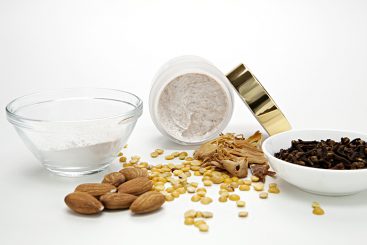
Organic and Natural Skin, Hair and Body Care
IS EXFOLIATION REALLY NECESSARY?
Yep, it sure is.
Exfoliation is an essential and effective step in your skincare routine, it does the prep work to ensure your skincare products to follow work more efficiently.
Regular exfoliation takes care of dull, dusty surface layers of dead skin build-up, keeps the complexion smooth, radiant and fresh, decongests, helps with skin discolouration and tackles impurities that can accumulate and clog pores. And, your make up will look noticeably more even, won’t settle into lines and flaws won’t be highlighted.
There are two types of exfoliants, physical and chemical.
Physical exfoliants, such as the OmVeda scrubs, are products containing tiny particles designed to manually remove dead surface cells, excess oil and other debris, revealing fresh skin cells underneath. Physical exfoliants aren’t just skincare products, they also include beauty tools like exfoliating gloves, brushes and even face cloths.
Chemical exfoliants, on the other hand, are chiefly in the form of resurfacing serums and use acids like AHA’s and BHA’s and enzymes to loosen surface cells and dissolve grime. These products can also come in the form of cleansers, toners, serums and creams.
Exfoliation gives your other products such as serums and moisturisers improved penetrating power, allowing them to do their work more efficiently. But remember, no serum or cream, regardless of how fabulous its formula, can do its job on desert dry, ashy, lizard like or dehydrated skin.
The key is not to scrub too hard, exfoliate too often or use harsh and aggressive ingredients that can cause sensitivity, irritation and inflammation. Over-doing it can upset and damage the skin barrier and the result can be dryness, flaky patches and redness.
Try exfoliating at night, rather than in the morning, as skin will be less vulnerable to sun damage. If you do exfoliate in the am, always remember to apply your sunscreen.
Exfoliation has great benefits, but no need to obsess, we recommend exfoliating once a week for drier skins and twice to three times per week for oilier types. For oily T-zones, concentrate on that area after you cleanse. Use gentle circular motions, it’s not necessary to rub hard. Be sure to use only one product that has exfoliating properties in your routine. Don’t reach for the cleanser or serum that contains AHA’s for example. Check your ingredients.
OmVeda has three physical exfoliators …. Walnut Scrub, Scrub Grains and Gold Scrub.
Our Walnut Scrub is a ready-made creamy formula for dry, dull and mature skin.
Our Scrub Grains and Gold Scrub are fine herbal powder Scrubs, called Ubtans. They are designed to be mixed with an OmVeda Toner or Water and/or patted onto damp skin and exfoliated over the skin using gentle, circular motions.
For oilier skins (and oily T-zones), our Scrub Grains and for normal to dry skins, our Gold Scrub (not suitable for sensitive skins).
THE BEAUTY OF MASKS
Chances are once a week, your night-time routine looks like this …… cleanse/remove makeup, tone, exfoliate and smooth on your favourite face mask.
Devotees of beauty love their mask’s rejuvenation benefits, their all-in TLC factor and their relaxation effect. Like a mini facial at home, to leave skin all dewy and supple, masks are the power plus remedy for skin issues with one to suit every skin type … mature, dry, sensitive or oily.
Masks come in all forms today .. sheet masks, clay masks, mud masks, peel off masks, overnight masks …. masks to clarify, to nourish, to repair, to firm .… you get the picture.
The concept of applying face masks is nothing new, in fact, their origins stretch way, way back, thanks to our goddesses of youth and beauty.
Beauty lovers in Egypt used clay for their masks. One of the most famous of beauty pioneers, Cleopatra, applied a mask of dead sea mud to draw out impurities and maintain her complexion and egg whites to tighten and give her skin a youthful glow.
In ancient Rome, beauty notables used oils and honey and moved to basil juice, vinegar, goose fat, snail ashes and other rather bizarre ingredients, all thought to possess healing properties.
In India, the origin of the mask is believed to date back some 5,000 years. It was those embracing the holistic lifestyle of Ayurveda, who created face and body masks called ‘Ubtan’, which historians consider as one of the first cosmetic products.
Ubtan mask ingredients did change with the seasons, however, they always included fresh herbs, plants like aloe vera, roots such as turmeric and also flowers. Prepared according to skin type to improve the skin’s appearance they also served and contributed to skin health.
These masks then became the ritual choice for women before religious ceremonies, festivals and weddings.
Yang Guifei, from the Tang Dynasty, known as one of the four ancient beauties of China, mixed water with ground minerals like pearl, rare jadeite, tea leaves, ginger root and lotus flower with natural rose water for a brightening effect. Mung beans, crushed tea, mint leaves and rice water were used to reduce wrinkles and dark circles.
In ancient Rome, beauty notables used oils and honey and moved to basil juice, vinegar, goose fat, snail ashes and other rather bizarre ingredients, all thought to possess healing properties.
European woman in Medieval times worked hard and resorted to wild and risky combinations and methods, to maintain their porcelain complexions. These included applying leeches to their faces and concoctions prepared with calf or hare blood to reduce dark patches and freckles.
Women vying for the ‘fairest complexion in the land’ in Victorian England used lead and vinegar, with disastrous results and ruthless skin issues.
In earliest South America, avocadoes were used to keep skin soft and supple and in Africa palm oil for a fair complexion.
In 1875, Madame Helen Rowley of Ohio in the USA created and patented her Toilet Mask, soft and flexible and made of pliable rubber. She designed it to be worn during sleeping hours to beautify, bleach and preserve the complexion.
In search of the perfect beauty mask, many women followed Madame Rowley with their own creations.
What stands out and remains to this day is the all-Ayurvedic, Ubtan. And, there’s more to share with you.
Some background:
In Ayurveda, ‘lepam’ means the application of herbal pastes which are called ‘kalka’ and ‘mukha’ means face. So, in essence, it’s the application of a herbal paste to the face.
Traditionally, some herbal pastes are used both internally (medicinally) and externally, ie for the body or the face.
Our Masks are prepared according to tradition, a holistic, authentic approach and formulated to time tested methods, steeped in the ancient Ayurvedic practice. They feature only natural and organically grown ingredients to improve the health and balance of the skin and leave it glowing.
We have a large selection of herbal masks which are in very fine powder form and ready-made masks. Both feature different combinations of minutely ground and/or crushed herbs, flowers, grains and seeds to address specific skin conditions, skin types and skin issues, ie oily, pigmented, dry, anti-ageing.
The Masks in powder form are designed to be freshly mixed (at time of use/treatment) with water, milk or yoghurt, applied to the face, neck and decollete and are incorporated into a salon facial or spa treatment. They include Thermo-Herbal Face Lift, Enzime, Skin Rejuvenator and Veg Peel.
Our ready-made Masks, for more convenient at-home use, are also suited to specific skin types, conditions and skin issues. These Masks can be used alone or mixed with fruits or vegetables.
Here are just a few.
Mango Butter Face Mask, for drier and pigmented complexions, is like a smoothie for the face. Hydrating and nourishing, the key ingredient of Mango rich in enzymes and high in vitamins C and E soothes, nurtures and leaves the skin supple. Added Sacred Lotus Seeds deeply hydrate and take care of dry, flaky patches in addition to soothing Honey to boost elasticity, Indian Barberry and Conch Shell. It can be used alone or ‘go traditional’ and add finely grated potato, cucumber or carrot.
Treating acne and blemishes, the Clove Acne Mask keeps breakouts at bay, its deep cleansing properties draw out impurities while minimising irritations, regulating oil production and balancing oilier conditions. Clove has powerful antiseptic qualities and helps heal breakouts. On the menu for this mask is Ashwaghanda Root for its astringent and rejuvenative properties.
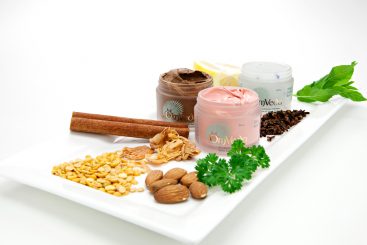
Returning a verve to the skin, our Pearl Mask contains finely ground Pearl Ash known to strengthen cell structure, address pigmentation issues, lighten tone and refine skin texture. It’s rich in calcium and valuable minerals and also helps minimise pores, revive lack lustre skin, reduce redness and address lines and wrinkles. In addition, it contains antioxidant and rich Jamun Fruit, a great remedy for scarring, blemishes and dark spots, Sandalwood and Wheatgerm, a rich source of Vitamin E and cooling Lotus. Its dual action of lightening and cooling ingredients makes this the ideal mask for sun related pigmentation.
Now you have a run-down and some background on the fascinating Ubtan (masks) traditional to Ayurveda.
Something more to share with you and that’s the care of your ready to go masks. After using, be sure to secure the cap and store in a cool, dry place. Should it get a little dry, we have an easy fix. To keep it moist and extend its life, add a little rosewater or food grade aloe juice and mix well, it will bounce back and be a breeze to apply.
Happy Masking!
STRAWBERRIES, LUSCIOUS HEART-SHAPED BEAUTIES for your skin
STRAWBERRIES, LUSCIOUS HEART-SHAPED BEAUTIES
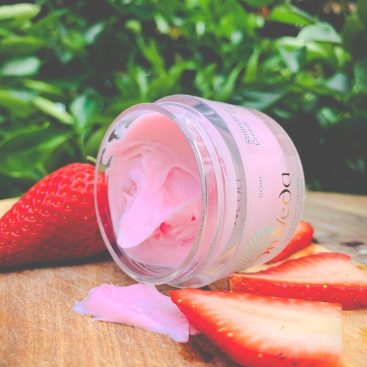
Strawberries are a super food with a place in our skincare routines and our diet
Did you know that Strawberries are not fruits or berries but belong to the Rose family.
These heart-shaped lovelies are packed with vitamins like C, B9 and K, antioxidants known as polyphenols, manganese, fibre and potassium.
We all love to eat them fresh, delicious in smoothies and yoghurt however, strawberries are pretty awesome for the body and the skin.
Being a source of vitamin C, strawberries are a well-recognised immunity booster and an essential for skin health, B9 (or folate) is crucial for cell function and normal tissue growth and potassium is involved in many key body functions including regulating blood pressure.
When it comes to the skin, strawberries get serious.
The Vitamin C in strawberries helps improve skin elasticity and resilience, brighten dulling skin and overall boost radiance.
They contain the amazing Ellagic Acid which guards against collagen destruction, a major cause of lines and wrinkles and also has a photo-protective effect that works to protect against UV damage and keeps the skin looking healthy.
The Folic Acid in strawberries aids in cell regeneration and keeps skin looking youthful and supple.
Plus, they contain Salicylic Acid to help address acne, reduce dry, dusty surface cells and fight excess oil.
Strawberries are a super food with a place in our skincare routines and our diet.
Using a Facial Oil and Benefits
Using a Facial Oil and the benefits of finishing your routine with one
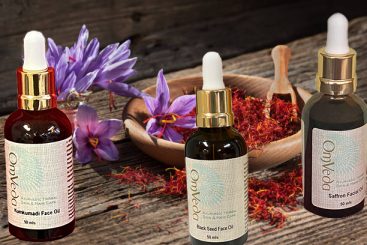 Our Facial Oils are awesome and everyone has their absolute favourite …. Kumkumadhi, Saffron or Black Seed.
Our Facial Oils are awesome and everyone has their absolute favourite …. Kumkumadhi, Saffron or Black Seed.
Silky textured, rich and luxurious, a Facial Oil is the dessert on the skincare menu. It’s the last step and final product applied in the daily beauty routine.
A Facial Oil locks in moisture, guards against further moisture loss, protects against the outside elements and helps strengthen the skin barrier.
Opposite to what we may believe, a face oil doesn’t actually hydrate, that’s not its job.
A face oil stays on the surface of the skin, it’s job is not to be deeply absorbed. It seals in the benefits of the ingredients already applied before it while it keeps skin soft, balanced, radiant and healthy. Think of it like a Topcoat for nails … a topcoat is the last step in a manicure, it works to protect against fading, chips, seals in colour, gives more staying power and keeps your manicure fresher for longer.
A face oil won’t make the complexion slippery, gooey or all-shiny. And every skin type … sensitive, dry, oily and acne-prone can enjoy its rewards.
Every face oil uses a carrier or base oil like Sesame as it’s safe to use on the skin. Carrier and base oils are from nuts, kernels or seeds and generally high in vitamins and nutrients, making them great for the skin. These include Almond, Apricot Kernel, Argan, Sesame Seed, Avocado, Jojoba and Grapeseed.
All our Face Oils use cold pressed 100% pure Sesame (Sesamum Indicum) Seed Oil as a base. This pale, yellow oil is obtained by pressing the seeds of the flowering plant. A ‘power nut’, the sesame seed is a reservoir of nutrients and bioactive compounds such as essential minerals, think magnesium, calcium and zinc and vitamins such as A, B1 and B2.
The oil from the sesame seed, often called the ‘Queen of Seed Oils’ delivers heaps of valuable properties for the skin including antioxidant, antimicrobial and anti-inflammatory and it’s non-comedogenic, so does not clog pores.
It contains Vitamin E to protect against damage from the environment. It is also rich in the most-wanted essential fatty acids such as oleic acid, to aid in repairing and calming, palmitic acid to help slow and guard against loss of water, stearic acid to soften and linoleic acid to plump the skin.
Sesame Seed Oil also has other wonders of its own … its antibacterial properties make it a great anti-acne weapon, it’s a detoxifier so helps reduce an oily shine and enlarged pores, it has moisturising benefits, thanks to the fatty acids and vitamins, that address crinkles and lines, it brightens, improves circulation and rejuvenates and it can help heal and improve scarring.
Our multi-functional facial oils …. Black Seed, Kumkumadi and Saffron are absorbed readily to protect, promote a glow and keep the skin ultra-smooth. While designed to be used as the final step in the skincare routine, a few drops can also be mixed with your OmVeda moisturising cream or lotion.
Our restorative Black Seed Oil, a lighter textured oil, brings skin back to life and its texture makes it a perfect warmer weather oil. While set in a base of Sesame Seed Oil, it’s boosted with Rice Bran Oil which is overflowing with polysaccharides, proteins, antioxidants, minerals and other phyto-nutrients, 100% natural Black Seed Oil and Jirakadi, a combination of Black Sesame and two varieties of Cumin. It’s a potent formula and the latest in our facial oil line up. Helping to build a healthier skin structure and integrity, it also targets ageing issues, blemishes, dark spots, redness, inflammation and scarring.
Evening out tone, refining texture, minimising under eye circles and calming, our Kumkumadi Oil is powered with 26 precious Ayurvedic herbs to keep skin supple and smooth while also addressing lines. It includes mainstays of Saffron and Turmeric with Madder, beautifying Rose, anti-inflammatory Liquorice, Vetiver to hydrate and the essential oils of Bergamot and Lavender.
Repairing damage, reducing pigmentation, breakouts and lines our Saffron Oil combines Turmeric to help neutralise toxins, strengthen and give the skin a glow. It partners with soothing Aloe Vera, Manjishta to stimulate circulation and carry vital nutrients to the tissues, Lotus, Rose and Indian Rose Chestnut to help ease skin irritations.
Our Facial Oils are truly awesome and we know everyone has their absolute favourite …. Kumkumadhi, Saffron or Black Seed.
When applying yours, take the time to massage in, as the skin can benefit greatly, and it only takes a few extra minutes. Facial massage boosts a healthier skin, increases blood circulation which in turn can help reduce puffiness and boost elasticity. Helping eliminate toxins, encourage cell repair and relax facial muscles, it can tighten muscles as well. It has a refreshing and rejuvenating effect, leaves the skin nourished and supple, improves it overall appearance and gives it a glow.
With all these benefits, adding a Facial Oil to your beauty routine definitely pays off.
What is Bhasma?

What is Bhasma?
And how is it used.
Ayurveda and other Indian systems of medicine use metals, but their use is also amply described in Chinese and Egyptian civilization in 2500 B.C.
Derivatives such as shells, metallic, non-metallic and herbals are normally administered as Bhasma. Bhasma, is an ayurvedic metallic/mineral preparation, treated with herbal juices or decoction and exposed for certain quantum of heat which is well known in the Indian subcontinent since 7th century A.D. and widely recommended for the treatment of many disease conditions.
Bhasma means an ash obtained through incineration. The starter material undergoes an elaborate process of purification and this process is followed by the reaction phase, which involves incorporation of some other minerals and/or herbal extracts.
There are various steps in making Bhasma, like maintaining optimum alkalinity for optimum health and neutralizing harmful acids. Bhasma does not get metabolized so does not produce any harmful metabolite, rather, it breaks down heavy metals in the body. Methods included in Bhasma preparation are parpati (thin flake like), rasayoga (chemical interactions between metals, minerals and herbs) and sindora (mixture of herbs and minerals).
Rasa-Shastra (vedic-chemistry) is one of the parts of Ayurveda, which deals with herbo-mineral/metals/non-metals preparations.
Rasayana (immune-modulation and anti-aging quality) and yogavahi (ability to target drugs to the site) are characteristics of a properly made herbo-mineral/metals/non-metals preparation, which is also non-toxic, gently absorbable, adaptable and digestible in the body.
Bhasma is claimed to be biologically produced nano-particles, which are prescribed with several other ayurvedic medicines.
Physical characteristic
Colour (Verna): A specific colour is mentioned for each Bhasma. Bhasma is generally white, pale, or red. The colour of the preparation primarily depends on the parent material.
Lustreless (Nishchandratvam): Bhasma must be lustreless before therapeutic application. For this test, Bhasma is observed under bright sunlight to indicate whether lustre is present or not, if lustre is still present, it indicates further incineration.
Lightness and Fineness (Varitara): Bhasma floats on a stagnant water surface. This test is based on law of surface tension. Properly incinerated Bhasma needs to float on the water surface.
Tactile sensation: Tactile sensation can be absorbed and assimilated in the body without producing any irritation to the mucous membrane of the gastrointestinal tract.
Particle size: Prepared Bhasma should be in powder form. Particle of Bhasma should be extremely fine.
Chemical characteristic
Apunarbhavata: It means incapability to regain original metallic form. For this test Bhasma is mixed with equal quantity of seeds of Abrus precatorius (a flowering plant of the pea family), honey, ghee and borax then sealed in earthen pots and heated with a similar grade of heat. Thereafter particular Bhasma is observed on self-cooling.
Niruttha: Niruttha is to test inability to regain metallic form of metallic Bhasma. In this test Bhasma is mixed with a fixed weight of silver leaf and kept in sealed earthen pots, then a similar grade of heat is applied and after cooling, the weight of silver is taken. Increase in weight of silver leaf indicates improperly prepared Bhasma.
Quality control of Bhasma
Traditionally, the end points of incineration of a metal and its conversion to a Bhasma are evaluated based on the following criteria:
Lustreless: There should be no shine or metallic lustre
Rekhapurnatvam: When a Bhasma is spread between the index finger and thumb and rubbed, it should be so fine as to get easily into the lines and crevices of the fingers and should not be washed out from the lines of the fingers.
Varitaratavam: When a small quantity is spread on cold and still water, it should float on the surface.
Apurnabhava: The Bhasma should not revert to the original state.
Tasteless: Bhasma should be tasteless.
Avami: The Bhasma should not produce nausea on administration.
Steps used to prepare Bhasmas
In Ayurveda, purification is called Shodhana. Shodhana is the process through which the external and internal impurities of metals and minerals are removed.
Process
Elimination of harmful matter from the drug.
Modification of undesirable physical properties of the drug.
Conversion of some of the characteristics of the drug to different stages.
Enhancement of the therapeutic action.
Marana
Marana is a burning process or calcination. The purified metal is placed into a mortar pestle and grounded with the juice of specified plants or kashayas (Ayurvedic drink) for a specified period of time.
Marana methods vary according to the substance to be calcinated. For example, organic substances such as herbs are burnt in open air, whereas inorganic substances such as metals like rajata (silver) are burnt in closed containers. The end product is a Bhasma of substance taken for marana. For example, the end product in the case of silver (rajata) is called as Rajata Bhasma.
Marana of inorganic substances is called puta and the process of marana of herbs in closed freshly made containers is known as puta-paka.
Bhasma obtained by marana from primary metals together with herbs (mulika) are called Mulikamarita Bhasma.
Gold (Swarna) Bhasma
The general preparation of Swarna Bhasma involves the three processes of shodhana, dravana, and marana. The leaves of gold are heated over fire and dipped in Sesamum indicum oil when its red hot and the process is continued seven times separately.
The soft leaves are processed with buttermilk/cow’s urine and the decoction of kulattha (Horse gram), kanji (sour gruel processed from rice Oryza sativa]), and radish (Raphanus sativus). Finally, the leaves are dried by heat. The mixture is ground and the paste obtained is dried under sunlight. The process of grinding and drying under sunlight is repeated 7 to 14 times and the final product is obtained.
Mukta Shouktic Bhasma (Pearl)
Mukta shouktic bhasma (MSB) is a traditional Ayurvedic medicinal preparation. This bio-medicine is synthesized through special calcination of mother of pearl as mentioned in the classical Ayurvedic text. It is found in the Indian Ocean and is a rich source of calcium.
This Bhasma is prepared from the outer covering of the shell (pearl-oyster), and ground with Aloe Vera and Vinegar in sufficient quantity to make a homogeneous paste. The recommended proportion of pearl-oyster and Aloe Vera is 1:4. It shows following pharmacological activity like antacid, anti-pyretic and as a source of calcium.
Recent studies have shown that adding heated oyster shells to the diet of elderly patients increased the bone mineral density of the lumbar spine.
Pearl is known for lightening skin tone naturally. It helps inhibit the tyrosinase enzyme that is responsible for the production of excessive melanin in the body. It actively lightens the dark spots, blemishes and acne marks. Thus, using pearl-infused beauty products help in making the skin tone even.
Purification of Diamonds
Types
Diamond is chiefly categorized into four types, mainly, white, red, yellow and black. According to ayurvedic scriptures, the diamond which is more-or-less round in size and possesses high gloss is termed as male.
The white coloured diamond is mainly suggested for internal administration, whereas the black and red-coloured varieties are significant in case of several health conditions and even prevent premature death of babies.
The yellow-coloured type is mainly used for providing strength.
Composition of Heerak Bhasma
It mainly contains carbon, iron and oxygen. But other essential elements that are present in moderate quantities include sodium, magnesium, potassium, calcium, chromium, aluminium, silicon, phosphorus, and sulphur.
The Diamond concoction is placed in a mortar pestle and ground well until it becomes fine powder.
Placed in a closed container and heated it in the absence of air.
Mixture is allowed to cool down on its own.
The process is repeated 14 times to get pure quality of Heerak Bhasma.
Be it used as a beauty ingredient for enhancing skin health or as a herbal compound for promoting health, diamond is the answer to all.
Diamond ayurvedic formulation with diamond known as Heerak Bhasma is extensively used for correcting the imbalance caused due to the Tridoshas, mainly Vata, Pitta and Kapha. It has corrective and anti – aging properties.
Conclusion
Bhasma contains metals and minerals and herbs. As a result of different stages of processing techniques like shodhana (which involves roasting, with addition of herbal juices and continuous stirring) and marana [which involves bhavana (wet grinding) and puta system of heating], the particle size reduces significantly, which may facilitate absorption and assimilation of the Bhasma into the body’s system rendering it safe.

